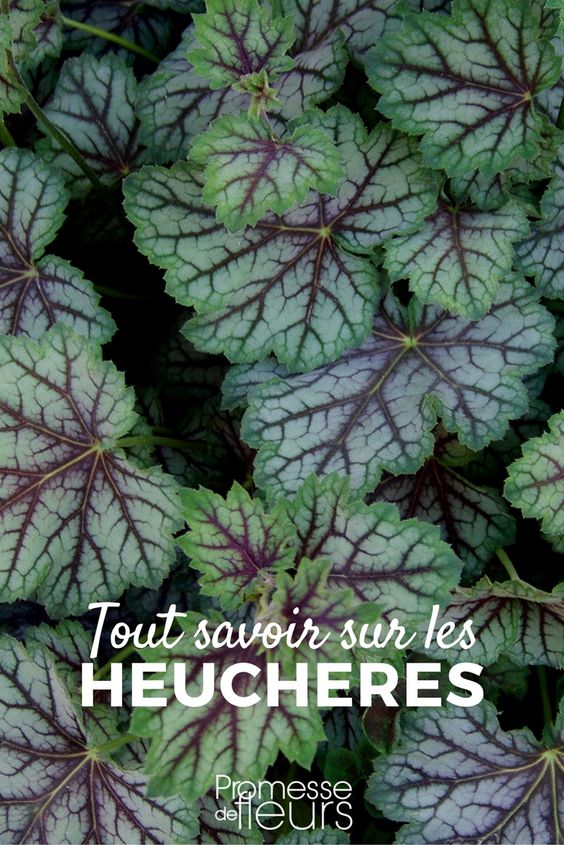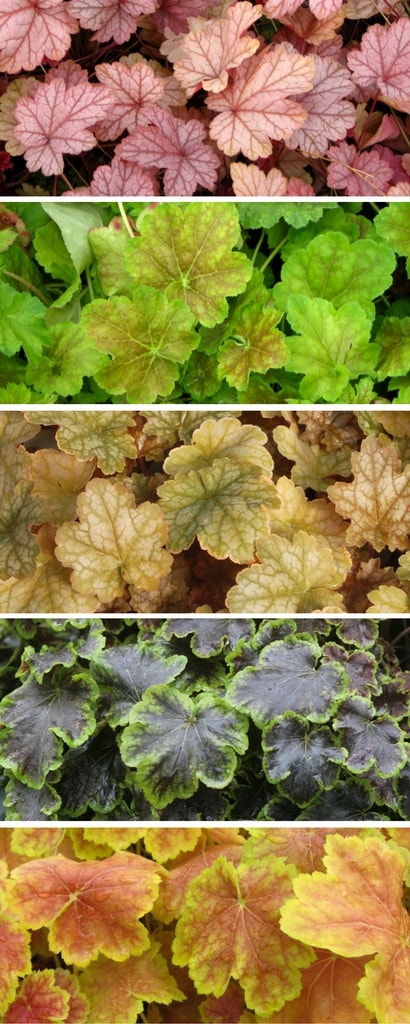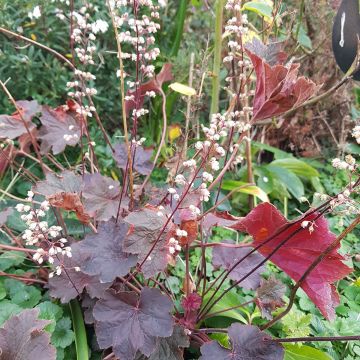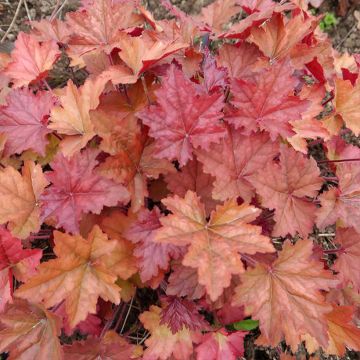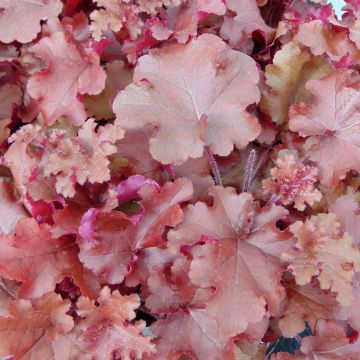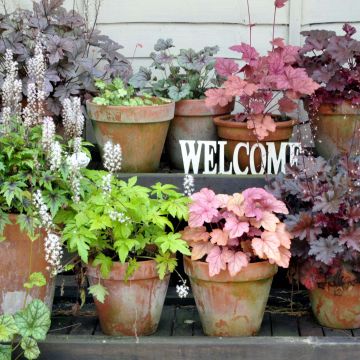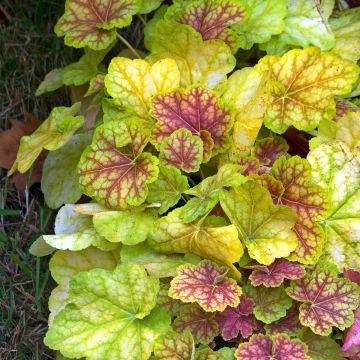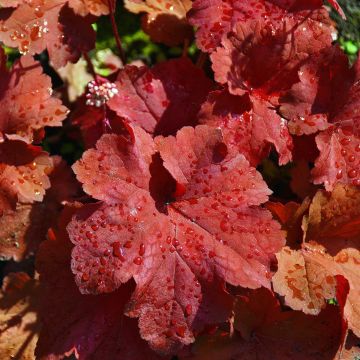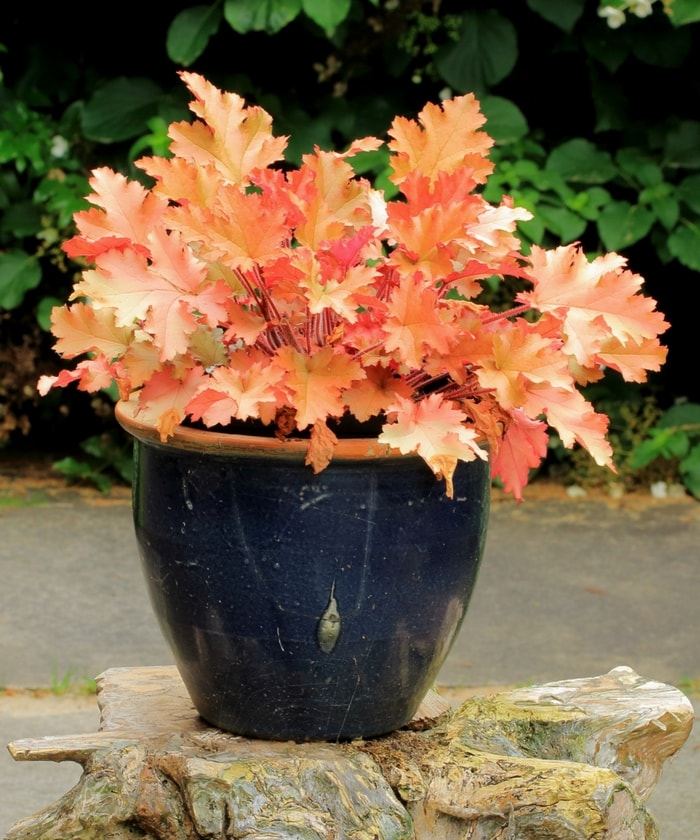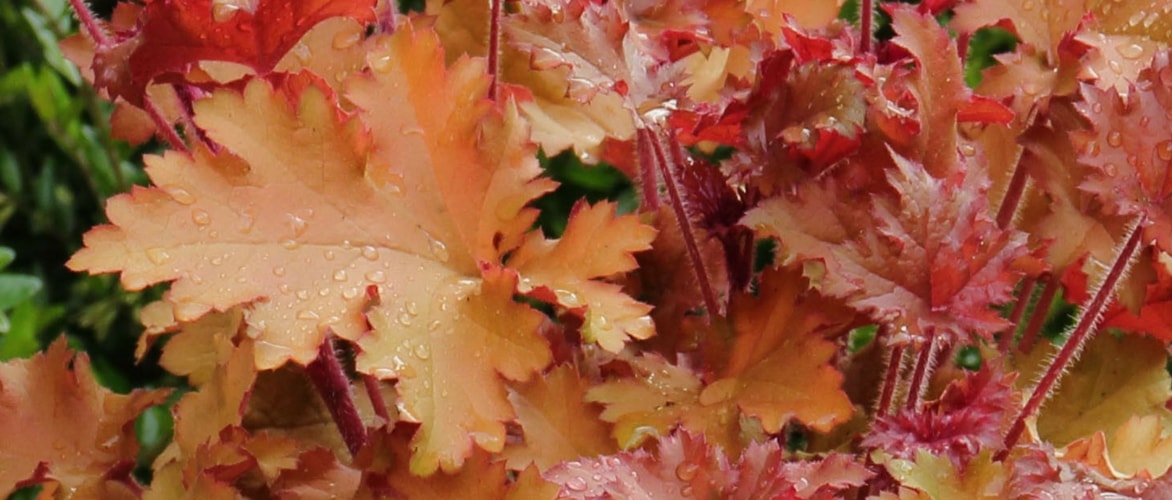
Heucheras: planting, growing and care
Contents
Heucheras in a nutshell
- Heuchera is the best perennial with colourful foliage! Its evergreen or semi-evergreen foliage is decorative for at least nine months of the year.
- It is suitable for shaded areas and tolerates dry shade well! Some varieties, such as Heuchera ‘Palace Purple’, also tolerate direct sunlight.
- Its foliage offers the greatest diversity of colours: it features all the colours of the rainbow except blue!
- In summer, it produces airy flowering in white, pink, or red, adding lightness to borders!
- Versatile, it is suitable for various uses: you can plant it as a border, as ground cover, in a pot composition, and even in rockeries.
- It is hardy and requires little maintenance.
A word from our Expert
Appreciated for its highly decorative foliage that lasts a long time, heuchera is a perennial plant that brings colour to the garden almost all year round! The evergreen varieties remain decorative even in the depths of winter. It is a great solution for enlivening shaded gardens or dressing the base of trees and bushes. Its delicate and airy flowering has earned it the nickname of “painter’s despair“. This appears in summer and often takes on white hues, but can also be pink or red.
Once out of fashion, they made a comeback in the 1980s with the arrival of new horticultural varieties, completely renewing their colour range. They now come in the most varied shades: from deep purple to bright golden yellow, including red, orange, or silver, and even pink. They continue to surprise us with their exceptional colours!
Very hardy, heuchera is easy to grow and requires little maintenance. It enjoys fresh, rich, and humus-bearing soils. Although it can be planted in open ground, feel free to plant it in a pot or container to create lovely compositions, paired with small perennials, bulbous plants, or grasses. It is best placed in partial shade, as it is sensitive to intense heat, and direct sunlight could scorch its foliage… This precaution is essential for the lighter-toned varieties, green or yellow, which are much more delicate in cultivation! In contrast, the varieties with purple foliage are the most resilient and can tolerate full sun.
Botany
Botanical data
- Latin name Heuchera sp.
- Family Saxifragaceae
- Common name Heuchera
- Flowering Between May and July
- Height 40 to 50 cm. And up to 80 cm when flowering.
- Exposure Shade, partial shade
- Soil type Rich, humus-bearing, cool, well-drained
- Hardiness Between -15 and -20 °C
The heucheras are perennial plants that originate from North America, where they are mainly found in mountainous regions. There are no fewer than 55 species and hundreds of varieties. Their very airy flowering, with a multitude of tiny flowers, has earned them the nickname “Painter’s Despair”.
The heuchera is named after the German physician and botanist Johann Heinrich von Heucher (1677-1747). Very fashionable in the 19th century, it then fell into obscurity, only to be rediscovered in the 1980s with the emergence of varieties with purple foliage. This was followed by a multitude of hybridizations that gave rise to the most varied shades.
It belongs to the family of Saxifragaceae. This family includes nearly 600 species of herbaceous plants, including Astilbes, Bergenias, and of course Saxifrages. Heucheras are very close to Tiarella, with which they hybridize to produce Heucherella. They are also cousins of Tellima and Tolmiea, two ground-cover perennials appreciated for their foliage.
The heuchera is a rather low plant: it will find its place at the front of borders. It generally measures 40 to 50 cm in height, and up to 80 cm when flowering. It grows in clumps or takes a spreading habit, which allows it to be used as a ground cover. It forms rhizomes, on which new clumps develop around the original plant. It is easy to multiply by taking these clumps!
The leaves of heucheras have incredibly diverse colours! They can take on red or orange shades, reminiscent of the fiery foliage of autumn, such as Heuchera ‘Marmelade’. They can also evoke the freshness of young spring shoots, with a soft green, bright: this is the case with Heuchera ‘Lime Rickey’, with almost fluorescent green leaves! They can take on very dark shades, like Heuchera ‘Obsidian’ with almost black foliage, or very bright colours, orange like Heuchera ‘Tiramisu’ or golden yellow like Heuchera ‘Citronelle’. They can also be purple, coppery, or have silver reflections. Everything seems possible in terms of colours!
The leaves of heucheras have soft shapes, with rather rounded edges. The leaf edges are sometimes undulated, giving them a crumpled appearance and allowing one to observe both sides of the leaves, often in different colours. In some varieties, they are bicoloured or marked with a border on the outer edge, like Heuchera ‘Beauty Color’. The veins, often very pronounced, sometimes create a contrast and give a superb marbled appearance!
Their foliage can take on different shades depending on the exposure. Generally, a single variety will have a slightly different colour depending on whether it is planted in sun or shade! The colours also change with the seasons, as seen in Heuchera ‘Peach Flambé’, whose leaves are peach-coloured in spring, then take on red shades, becoming purple in winter.

The inflorescence of heucheras
Heucheras flower in summer, between May and July, sometimes until August. Generally, they are now more cultivated for their foliage than for their flowering! The heucherella, resulting from the cross-breeding between heucheras and tiarellas, have more significant flowerings, with upright spikes of white or pink. However, Heuchera sanguinea ‘Leuchtkäfer’ offers a charming scarlet flowering!
The inflorescences of heucheras consist of a multitude of small bells arranged on an upright stem. This gives them a very airy and vaporous appearance. They are often cream-white in colour, but can also be pink or red. This is the case with Heuchera ‘Pluie de Feu’, which is particularly appreciated for its flamboyant flowering!
The heuchera is a good melliferous plant, its flowers are visited by bees, butterflies, hoverflies, and hummingbird moths. They can also be used in the composition of bouquets.
The fruit of the heuchera has little ornamental interest. It consists of small capsules ending in fine points, containing many tiny brown seeds.
Botanical species
- Heuchera americana
Native to the eastern United States and Canada, this species has evergreen foliage, green with silver reflections. It has given rise to many varieties. It is sensitive to heat and drought, so plant it in the shade!
- Heuchera sanguinea
This species is remarkable for its splendid bright red flowering, which lasts a long time! Its leaves, green and rounded, are more ordinary. It does not like humidity but tolerates full sun and calcareous soils.
- Heuchera micrantha
It is native to the west coast of the United States, where it grows on cliffs and rocky slopes. Its green leaves can take on reddish or purple shades. It is the one that has given rise to the purple varieties and dark foliage! It tolerates wet soils well.
Read also
How to plant heucheras?The main varieties of heucheras
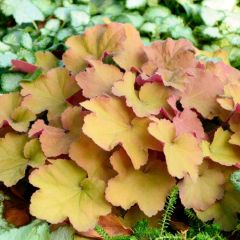
Heuchera villosa Caramel
- Flowering time July, August
- Height at maturity 50 cm
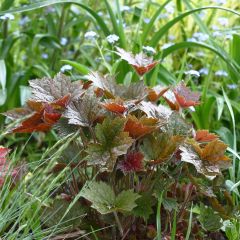
Hesperis matronalis var. albiflora Alba Plena
- Flowering time July, August
- Height at maturity 50 cm
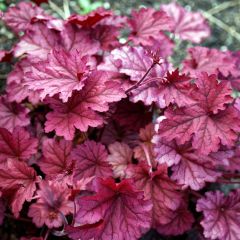
Heuchera Berry Smoothie
- Flowering time July, August
- Height at maturity 45 cm
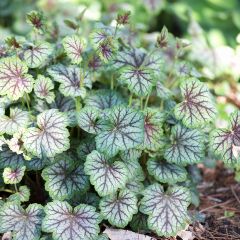
Heuchera Green Spice
- Flowering time June, July
- Height at maturity 40 cm
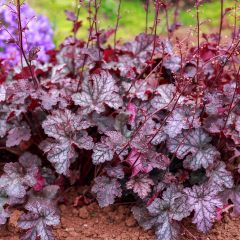
Heuchera Georgia Plum
- Flowering time July, August
- Height at maturity 30 cm
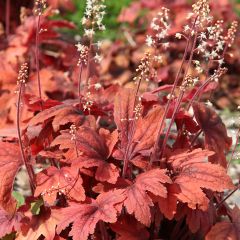
Heuchera micrantha Marmalade
- Flowering time July, August
- Height at maturity 35 cm
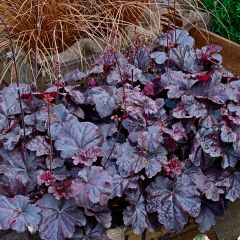
Heuchera Obsidian
- Flowering time July, August
- Height at maturity 30 cm
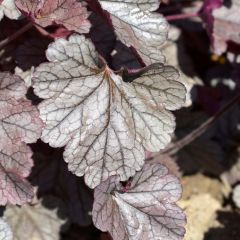
Heuchera Prince of Silver
- Flowering time June to August
- Height at maturity 35 cm
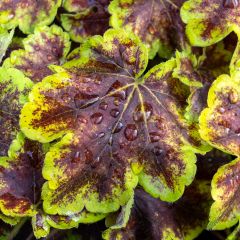
Heucherella Solar Eclipse
- Flowering time June, July
- Height at maturity 35 cm
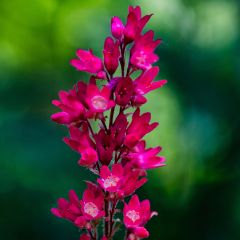
Heuchera sanguinea 'Leuchtkäfer'
- Flowering time July, August
- Height at maturity 60 cm
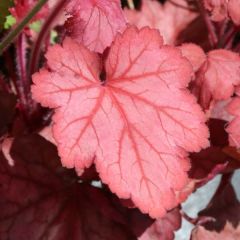
Heuchera Georgia Peach
- Flowering time July, August
- Height at maturity 60 cm
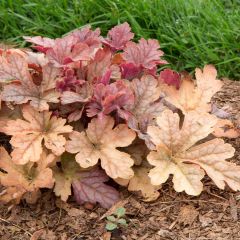
Heucherella Honey Rose
- Flowering time July to September
- Height at maturity 35 cm
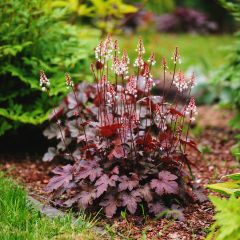
Heuchera Chocolate Ruffle
- Flowering time July, August
- Height at maturity 30 cm
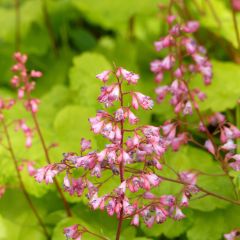
Heuchera hybrida Little Cuties Sweet Tart
- Flowering time June to November
- Height at maturity 25 cm
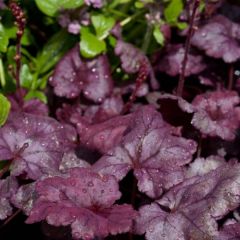
Heuchera Plum Royale
- Flowering time July, August
- Height at maturity 35 cm
Discover other Heuchera
View all →Available in 1 sizes
Available in 0 sizes
Available in 1 sizes
Available in 1 sizes
Available in 0 sizes
Available in 1 sizes
Available in 1 sizes
Available in 2 sizes
Available in 1 sizes
Available in 1 sizes
Planting heucheras
Where to plant?
You can plant your heucheras in the ground or in pots. They thrive in rich, humus-bearing, cool and well-drained soils. Avoid heavy or clayey soils, or create drainage by adding gravel or clay pebbles. Plant them in soil that does not dry out too much during the summer. They are not very sensitive to soil pH.
Place them in shade or partial shade, sheltered from excessive heat and direct sunlight… especially if you choose varieties with light foliage, such as Heuchera ‘Lime Rickey’! The sun could scorch their leaves. Purple or dark varieties tolerate it much better. This is the case for Heuchera ‘Obsidian’. Varieties descending from Heuchera villosa (like Heuchera ‘Berry Smoothie’) are quite robust and withstand heat and drought well. Those derived from Heuchera sanguinea, such as the variety ‘Leuchtkäfer’, dislike humidity but cope well with calcareous soils and full sun!
When to plant?
You can plant heucheras in autumn or in spring.
How to plant?
Planting heucheras is quite simple. By following a few points, you can easily establish them in your garden:
- Choose a suitable location, in light soil and partial shade
- If your soil is heavy, add leaf compost or pumice to lighten it
- You can also add compost to enrich the soil
- Do not hesitate to bury the basal stem during planting.
Planting in the ground:
Maintain at least 40 centimetres of distance between two plants.
Moisten the root ball by placing it in a basin filled with water to facilitate the plant’s recovery. Dig a planting hole about twice the size of the root ball. Your soil must be well-drained as heucheras do not appreciate stagnant moisture! If it is clayey, place a layer of gravel or pumice. Add a few handfuls of compost to enrich the soil. Position the root ball and replace the soil, burying the basal stem (where there are no leaves). Gently firm the soil and water. We recommend adding a layer of mulch around the plant to keep the soil cool.
Planting in pots:
Heucheras are perfect for pot or container cultivation! Choose a container that is wide and deep enough. Start by placing the root ball in a basin filled with water for a few minutes. Drain the bottom of the pot with gravel, clay pebbles, or broken pot pieces. Add the substrate (compost mixed with a bit of sand) and place the plant, slightly burying the base of the stem. Add more substrate around the edges to balance the soil level. Gently firm the soil, water, and then place the pot in partial shade, sheltered from direct sunlight. When composing a wide pot arrangement, we suggest positioning your heucheras near the edge for a more beautiful effect… their leaves can then spill over the outside of the pot!
→ Learn more with our advice sheet: Growing a Heuchera in a pot
Care
Heucheras are quite resistant to diseases and pests. When grown in pots, they are sometimes attacked by the Vine Weevil (Otiorhynchus sulcatus). Its larvae feed on the roots, while the adults target the leaves. Unfortunately, their presence is not easy to detect. Inspect the leaves, as the adults nibble at the edges! To get rid of them, use nematodes that will eliminate the larvae present in the soil. As a preventive measure, we recommend applying a mulch at the base of your heucheras, making it more difficult for adult weevils to lay their eggs in the soil. Remove affected plants, and if you are growing them in pots, change the substrate. If they are planted in open ground, birds will eat the larvae. So there is no need to worry!
Heucheras prefer cool soils: place a layer of mulch at their base to prevent the soil from drying out! By maintaining a cool soil for heucheras grown in the sun, you will limit the risk of leaf scorch. Additionally, mulching will enhance the colours of their foliage! Water the heucheras during the summer, at least in case of prolonged drought.
Heucheras enjoy rich soils: add a few handfuls of compost at their base in spring or autumn. At the end of winter, in March-April, cut back the old dried leaves. In summer, regularly remove faded flowers. Heucheras are hardy and do not require winter protection.
A few years after planting, heucheras may become exhausted, look less attractive, and have slowed growth. They develop a woody stem and the base of the clump becomes bare. We therefore recommend renewing them every three to five years in autumn. Dig them up and replant the younger ones, positioning the collar (the base of the leaves) just at soil level. Firm the soil around the plant and water. Take the opportunity to divide them and make cuttings!
Propagation of Heucheras
Heucheras are easy to propagate by cuttings or by clump division. You can also sow them, but the plants you obtain may not be identical to the parent plant! As heucheras tend to exhaust themselves after a few years, dividing and propagating them regularly (ideally every three years) will allow you to obtain more vigorous young plants!
Clump Division
Divide the largest clumps, preferably in autumn, around October. Heucheras naturally spread by producing running rhizomes, which give rise to new clumps around the main one. To propagate, simply detach these by cutting them with pruning shears, remove any damaged leaves, and replant the best clumps in pots filled with substrate, burying them slightly. Water and place them in a sheltered, bright location to overwinter. In spring, you can plant them in the ground.
Cuttings
Propagate your heucheras in autumn! Start by preparing a pot filled with substrate (ideally, potting soil mixed with heather soil). Choose a plant that has been growing for a few years and has developed a stem. Take a stem by cutting it at the base with a knife, ensuring you keep at least five or six centimetres. Remove the old leaves, leaving only two or three of the young leaves located at the centre of the clump. Replant it by pushing it sufficiently into the substrate. Gently firm the soil around the stem and water. Place the pot in a bright location, but out of direct sunlight.
Continue to water moderately, allowing the soil to dry between waterings. You can plant them in their final location in spring.
Finally, discover our video How to Propagate Heucheras with Olivier:
Association
With their evergreen or semi-evergreen foliage, heucheras bring colour to borders almost all year round! You can use them as ground cover at the base of trees and bushes, at the front of borders, in rockery, or even in pots or containers. Plant them in groups of at least three or five young plants and mix the varieties for a very colourful effect!
Varieties with dark foliage have the ability to highlight the brilliance of bright flowers! For example, use Heuchera ‘Chocolate Ruffles’ to reveal the intense orange hue of Tulipa ‘Orange Princess’.
Similarly, play with colours by designing a purple and anise garden! The golden hues of Lysimachia nummularia ‘Aurea’ and Hakonechloa macra ‘Aureola’ will highlight the dark purple foliage of Heuchera ‘Velvet Night’ to create a striking contrast! This will result in an original and impressive scene.
As they thrive in partially shaded situations and cool soil, don’t hesitate to plant heucheras at the woodland edge, alongside ferns, hostas, and a few flowers: for example, hardy geraniums or bluebells. You will achieve a very natural style garden!
Let your creativity flow and create charming flower compositions, combining them with small perennials, bulbs, or grasses. The possible combinations are endless!
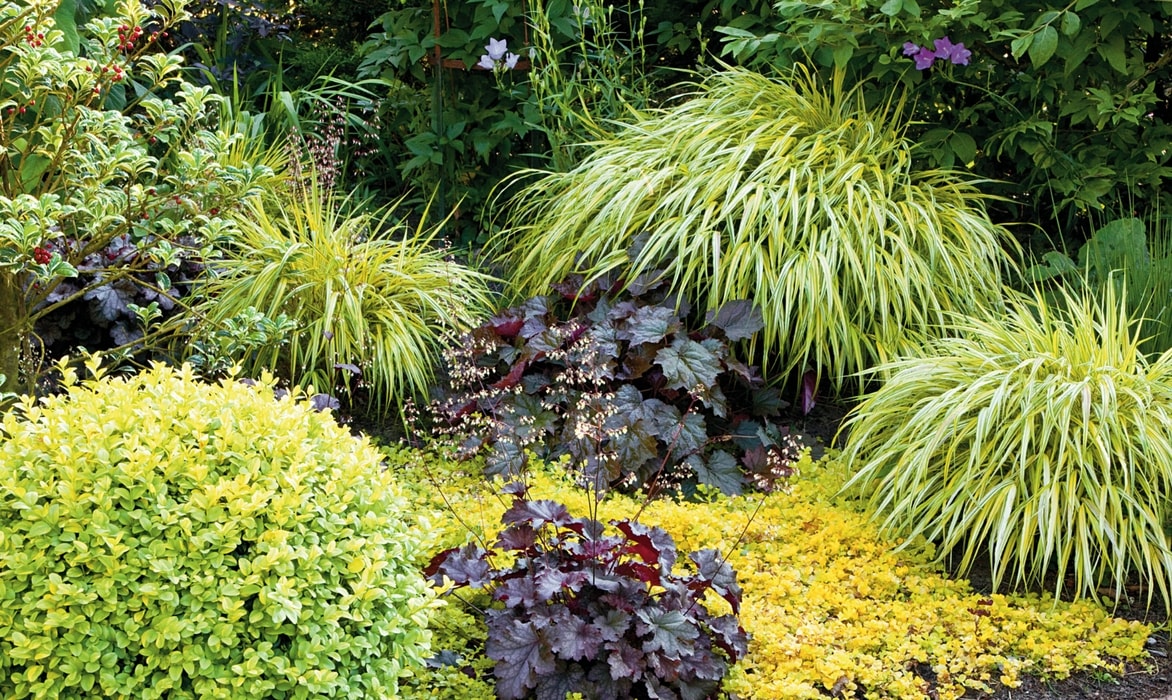
A purple and anise garden with Heuchera ‘Velvet Night’! Copyright GAP Photos Elke Borkowski
For more inspiration, check out our article: “Heuchera: 7 successful pairing ideas
Useful resources
- Our very wide range of Heucheras!
- Practical advice sheet: “How to plant Heucheras“
- Check out our advice sheet: Growing a Heuchera in a pot
- Discover 6 Heucheras with golden foliage, 7 Heucheras with orange foliage and 6 Heucheras with silver foliage, 7 Heucheras with purple foliage
- Our advice sheet: Heucheras, the most beautiful varieties
- Check out our tutorial: How to multiply Heucheras?
Frequently asked questions
-
My heuchera isn't growing! What should I do?
If it is already a few years old, it needs to be rejuvenated! Heucheras become exhausted and less beautiful and vigorous over time. Divide the clumps every three to five years. In autumn, dig them up and replant the younger clumps.
-
My heuchera is yellowing and declining despite my care! What should I do?
Your plant is likely being attacked by vine weevils. The larvae feed on the roots of potted heucheras! Look for their presence, check if the leaves are not eaten at the edges (damage caused by adult vine weevils), and if necessary, dig up a plant to see the condition of its roots. If you find vine weevils, treat with nematodes.
-
The leaves of my heuchera seem burnt!
This occurs when heucheras are exposed to direct sunlight, especially if they are light-toned varieties, such as Heuchera ‘Lime Rickey’. Dark-foliaged varieties are more resistant to full sun. Generally speaking, plant your heucheras preferably in partial shade! Additionally, prolonged drought makes heucheras more susceptible to foliar burns. They tolerate the sun better when the soil remains cool. Don't hesitate to install a layer of mulch at their base!
-
The leaves of my heuchera seem to have been eaten!
It is undoubtedly the otiorhynchs. They are the main enemy of heucheras! Adults chew the leaves into lace by eating the edges. Unfortunately, the most serious problem is caused by the larvae, which consume the roots of the plant. You may consider digging up a young plant to check the condition of its roots. Get rid of the most infested plants. Dig up the young plants and keep only the healthy shoots. We recommend a solution based on nematodes (biological control). These tiny worms parasitise the larvae of otiorhynchs. They come in the form of a solution (powder) to be diluted in water and sprayed onto moist soil in spring or summer. This type of nematode is harmless to plants, unlike leaf eelworms, other nematodes that can attack heucheras.
-
The leaves of my heuchera are discolouring between the veins!
The culprit is likely the leaf eelworm. These are harmful nematodes that parasitise the plant by entering its leaves and stems. Remove the infested parts, and limit watering as they thrive in humidity. Plant marigolds, as they repel them! If your heuchera is in a pot, repot it in healthy soil. You can also spray a solution based on pyrethrum.
-
My heuchera has a slightly different colour than expected!
If the difference is quite limited, that's normal; heucheras tend to take on different shades depending on whether they are placed in shade, partial shade, or sunlight. Moreover, the foliage of certain varieties changes throughout the seasons. If your heuchera appears unappealing, don't hesitate to move it to a location that suits it better, whether that be brighter or more shaded.
- Subscribe!
- Contents
